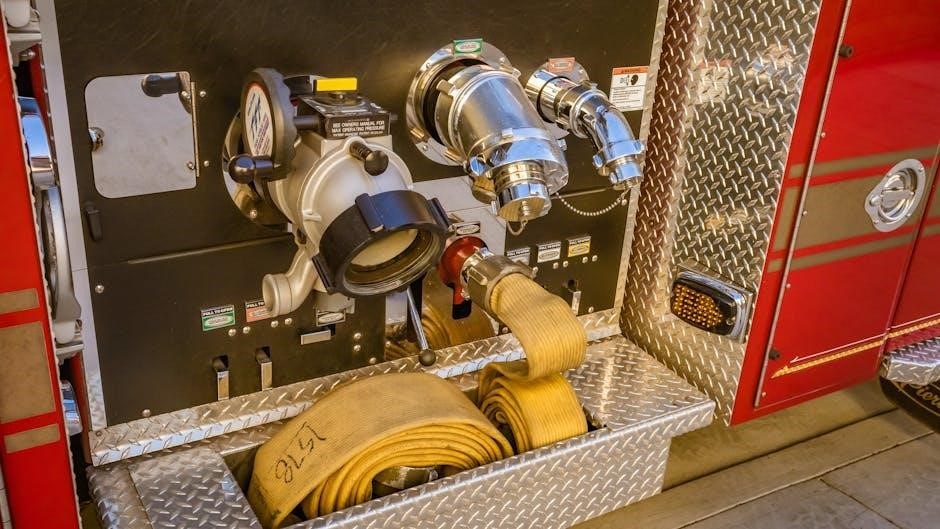AS 2441-2005 outlines the installation of fire hose reels, crucial for fire safety systems. It ensures proper design, location, and maintenance, enabling effective early fire suppression and public safety.
Overview of AS 2441 Standard
AS 2441-2005 is the Australian Standard for the installation of fire hose reels, developed by Committee FP-007. It provides comprehensive guidelines for the design, installation, commissioning, and maintenance of fire hose reel systems. The standard ensures fire hose reels are reliable, effective, and safely integrated into fire safety systems. It specifies requirements for water supply, distribution, and system performance, ensuring compliance with fire safety regulations. AS 2441 also references other critical standards, such as AS 1851-2005 for maintenance, to ensure a holistic approach to fire safety. This standard is essential for ensuring fire hose reels operate efficiently in emergency situations.
Importance of Fire Hose Reels in Fire Safety Systems
Fire hose reels are vital components in fire safety systems, enabling quick response to early-stage fires. They provide accessible water supply for manual firefighting, reducing fire escalation risks. Compliant with AS 2441, these reels ensure reliability and effectiveness in emergency situations. Properly installed and maintained hose reels enhance building safety, protect occupants, and minimize property damage. They are designed for ease of use, allowing individuals to act swiftly. AS 2441 ensures reels meet performance standards, making them indispensable in fire safety strategies. Regular maintenance and adherence to standards like AS 1851-2005 further ensure their functionality, reinforcing their critical role in fire protection systems.
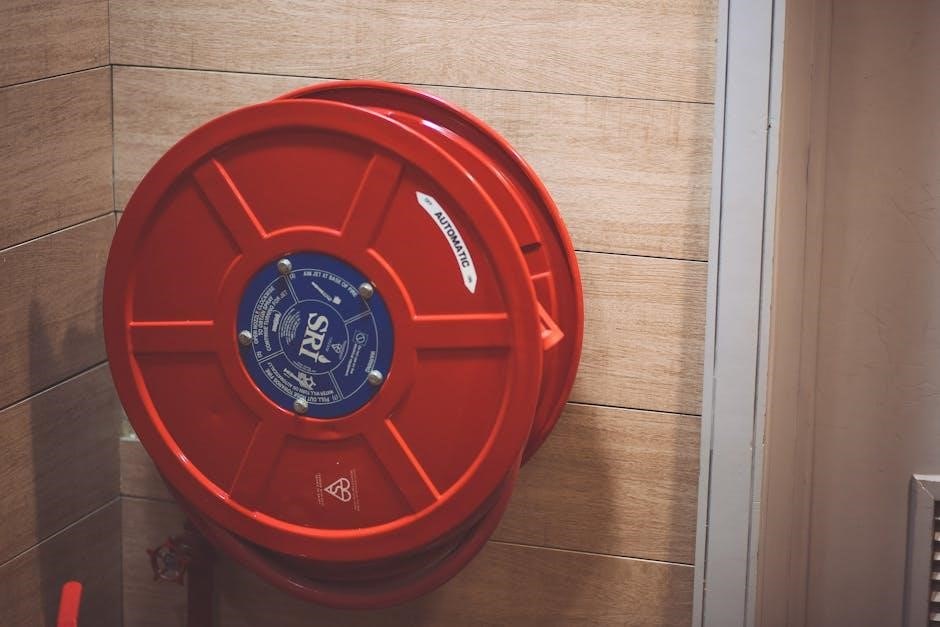
Key Components of AS 2441 Fire Hose Reels
AS 2441 fire hose reels include durable hoses, robust reels, and reliable connection points. They are designed for easy access and effective water supply in emergencies.
Scope and Objectives of the Standard
The AS 2441-2005 standard provides detailed guidelines for the design, installation, and maintenance of fire hose reels. Its primary objective is to ensure fire hose reels operate reliably in emergency situations. The standard covers specifications for water supply, hose size, and reel construction, ensuring compliance with safety and performance requirements. It applies to various fire safety systems, focusing on accessibility, visibility, and protection against damage. The standard also outlines testing procedures to verify system effectiveness. By adhering to AS 2441, installers, manufacturers, and maintainers can ensure fire hose reels meet the necessary benchmarks for fire suppression and public safety.
Design and Construction Requirements
AS 2441-2005 specifies that fire hose reels must be designed to deliver water at a minimum rate of 0.33 liters per second for 19mm hoses. Reels should be constructed from durable materials resistant to corrosion and mechanical damage. The standard mandates smooth hose surfaces and secure connections to ensure reliable operation. Hose reels must also incorporate a drainage system to prevent water retention, reducing the risk of damage or contamination. Testing procedures are outlined to verify that reels meet these requirements, ensuring optimal performance in emergency situations. Proper design and construction are critical to maintaining fire safety standards and public safety.
Installation and Location Guidelines
AS 2441-2005 provides detailed installation and location guidelines for fire hose reels to ensure accessibility and effectiveness in emergency situations. Reels must be installed in visible, easily accessible locations, such as corridors or near exits, and protected from mechanical damage. The standard specifies that fire hose reels should be positioned no higher than 1.5 meters above the floor to facilitate quick access. Additionally, they must be located within 4 meters of a fire hydrant or water supply source. Proper signage is required to indicate the reel’s location, ensuring rapid identification during emergencies. Compliance with these guidelines ensures optimal functionality and safety.
Maintenance and Inspection Recommendations
AS 2441-2005 emphasizes regular maintenance and inspections to ensure fire hose reels remain functional and compliant. Reels should be inspected every six months, as per AS 1851-2005, to check for damage, corrosion, or blockages. Water flow tests must be conducted to verify the reel’s performance, with a minimum flow rate of 0.33 liters per second for 19 mm hoses. Signs of wear, such as frayed hoses or faulty nozzles, should be addressed promptly. Maintenance records must be documented and retained for audit purposes. Properly maintained fire hose reels ensure reliability in emergencies, preventing potential safety risks and non-compliance with fire safety regulations;
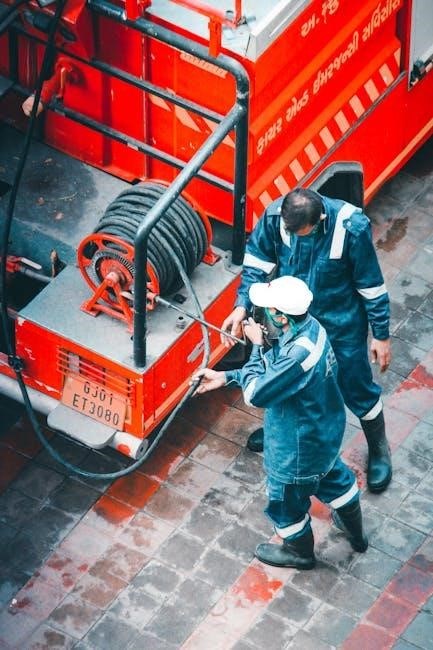
Related Australian Standards and Compliance
AS 2441-2005 aligns with AS 1851-2005 for maintenance, AS 2118 for performance, and AS/NZS 1221 for certification, ensuring comprehensive compliance in fire safety systems nationwide.
AS 1851-2005: Maintenance of Fire Protection Systems
AS 1851-2005 provides comprehensive guidelines for maintaining fire protection systems, including fire hose reels. It emphasizes regular inspections and testing to ensure system reliability and compliance. Section 3 of this standard outlines specific maintenance requirements, while Section 14 focuses on detailed inspection procedures. The standard recommends six-monthly maintenance intervals for fire hose reels to ensure optimal functionality. Compliance with AS 1851-2005 is crucial for maintaining fire safety standards and ensuring that fire hose reels are ready for immediate use in emergencies. Proper maintenance also extends the lifespan of equipment, reducing risks and ensuring public safety.
AS 2118: Fire Hose Reels Performance Specifications
AS 2118 outlines performance specifications for fire hose reels, ensuring they meet critical operational requirements. It details standards for hose size, length, and construction, as well as flow rates and pressure resistance. Compliance with AS 2118 ensures fire hose reels deliver reliable performance in emergencies. The standard aligns with AS 2441, focusing on design and functionality to support effective fire suppression. Regular testing and inspection are recommended to maintain compliance and ensure the reels operate as intended. This standard is essential for ensuring fire hose reels are durable, efficient, and capable of withstanding operational demands, thereby safeguarding public and property safety.
AS/NZS 1221: Certification and Manufacturing Standards
AS/NZS 1221 establishes certification and manufacturing standards for fire hose reels, ensuring compliance with safety and quality requirements. This standard mandates rigorous testing and inspection of materials, design, and construction to guarantee reliability in emergency situations. It also requires third-party certification, such as Global-Mark, to verify adherence to specifications. Manufacturers must demonstrate that their products meet performance, durability, and safety criteria. Compliance with AS/NZS 1221 is essential for maintaining trust and ensuring fire hose reels function effectively. This standard complements AS 2441 and AS 1851, providing a framework for the production of high-quality fire safety equipment. Proper certification ensures public safety and system integrity.
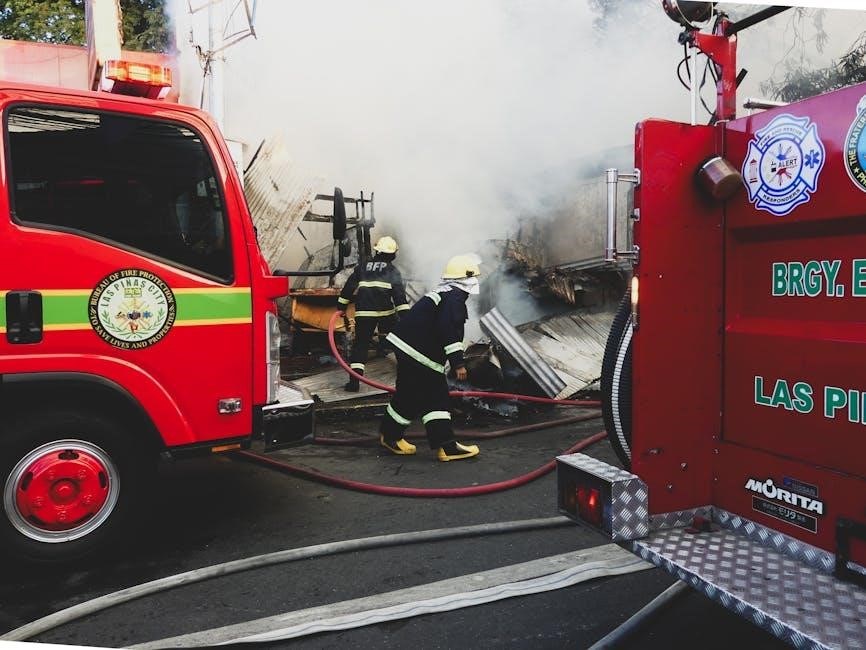
Commissioning Procedure for Fire Hose Reels
The commissioning process involves testing fire hose reels post-installation, ensuring functionality, water flow, and compliance with AS 2441 and NZS 4503 standards, followed by detailed documentation.
Pre-Installation Checks and Tests
Before installing fire hose reels, ensure the water supply meets the required flow rate specified in AS 2441-2005. Verify the hose reel’s compatibility with the building’s layout and fire safety needs. Conduct checks on the hose condition, ensuring it is free from damage or blockages. Test the reel’s spring tension or motorized mechanism to ensure smooth operation. Confirm that all components, such as nozzles and fasteners, are compliant with the standard. Perform a visual inspection of the installation area to ensure no obstructions exist. Finally, review the manufacturer’s instructions and ensure all pre-installation criteria are met to guarantee system readiness and reliability.
Post-Installation Testing and Documentation
After installing fire hose reels, conduct thorough testing to ensure functionality. Check water flow rate, pressure, and hose nozzle operation, verifying compliance with AS 2441-2005. Inspect for leaks in connections and ensure smooth reel rotation. Document all test results, including water supply performance and system readiness. Prepare a commissioning certificate and maintenance schedule, referencing AS 1851-2005 for ongoing inspections. Maintain detailed records of installation, testing, and compliance for regulatory audits. Proper documentation ensures accountability and adherence to safety standards, guaranteeing the fire hose reel system is reliable and ready for emergency use.
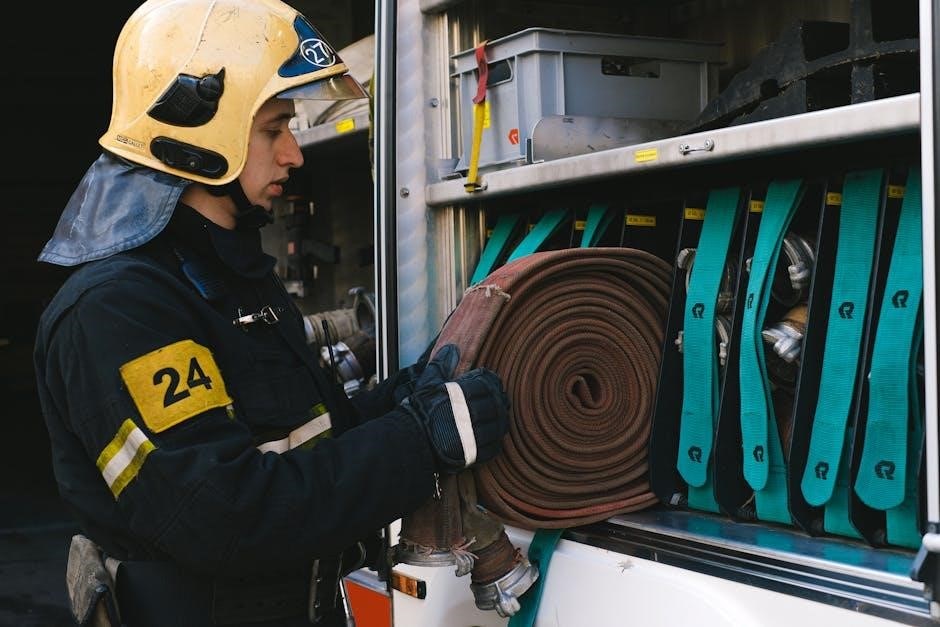
Safety Considerations and Best Practices
Ensure fire hose reels are protected from mechanical damage and corrosion. Regularly inspect and maintain hose condition, connections, and nozzles. Always follow AS 2441 guidelines for safe operation.
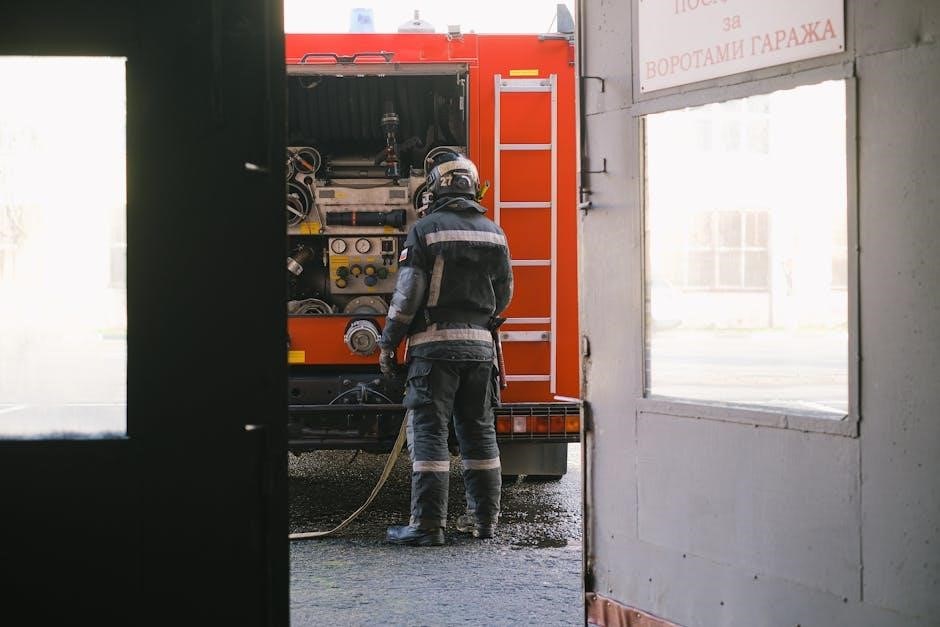
Proper Usage and Handling of Fire Hose Reels
Proper usage of fire hose reels is essential for effective fire suppression. Always ensure the hose is fully unwound before use and avoid kinking or tangling. Regular inspections and maintenance, as outlined in AS 2441, are critical to ensure functionality. Train users to operate the reel correctly, emphasizing smooth rewinding to prevent damage. Store reels in accessible locations, protected from mechanical stress and corrosion. Annual drills and hands-on training can enhance readiness and safety. Adhering to these practices ensures the fire hose reel remains a reliable tool in fire emergencies, aligning with the standard’s guidelines for optimal performance and safety.
Protection Against Mechanical Damage and Corrosion
Protecting fire hose reels from mechanical damage and corrosion is crucial for their longevity and functionality. AS 2441 recommends using durable materials and finishes, such as galvanized or stainless steel, to resist corrosion. Install reels in areas sheltered from harsh weather and physical impacts. Regular inspections should check for signs of wear, rust, or damage. Proper storage and maintenance, including cleaning and lubrication, further extend service life. Strategic placement in accessible yet protected locations minimizes exposure to harmful conditions. These measures ensure the fire hose reel remains reliable and ready for emergencies, aligning with the standard’s focus on safety and performance.

AS 2441 fire hose reels are essential for fire safety, ensuring proper installation and maintenance. Compliance with this standard guarantees reliability and effectiveness in emergency situations.
AS 2441-2005 provides comprehensive guidelines for the installation, design, and maintenance of fire hose reels, ensuring compliance with fire safety standards. It specifies requirements for water supply, reel placement, and protection against damage. The standard emphasizes regular maintenance and testing to guarantee reliability in emergency situations. Compliance with AS 2441 ensures fire hose reels are functional, durable, and ready for immediate use. This standard is essential for maintaining fire safety in commercial and residential buildings, aligning with broader fire protection regulations like AS 1851-2005 and AS/NZS 1221. Its adherence ensures public safety and effective fire management systems.
Future Directions in Fire Safety Equipment
The evolution of fire safety equipment, including fire hose reels, is expected to focus on smart technologies and innovative materials. Future advancements may include intelligent systems that monitor equipment health and predict maintenance needs. Sustainable materials and energy-efficient designs could become standard, reducing environmental impact. Integration with building management systems and IoT devices may enhance functionality and response times. Additionally, there may be a shift toward modular and adaptable fire safety solutions, allowing for easier upgrades and customization. These developments aim to improve reliability, efficiency, and safety, ensuring fire hose reels remain a critical component in modern fire protection systems for years to come.
